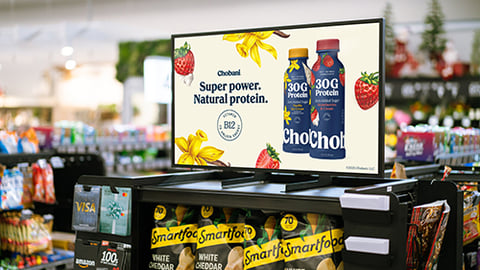Grocers Focus on Retail Media Networks
While they’re actively taking advantage of social media promotions, recent years have also seen more grocers harnessing the advanced analytics and AI components inherent to retail media networks (RMNs). This allows them to stage targeted, personalized and effective consumer retail media campaigns, possibly alleviating the need to invest heavily in social commerce.
CPG-related omnichannel retail media spending was $19.1 billion in 2024; for 2025, spending is estimated to be $22.3 billion. For 2026, it’s expected to reach $25.6 billion, according to Arlington, Va.-based FMI – The Food Industry Association in a 2025 report, “The Evolution of Retail Media: Decoding What Works and What Doesn’t.” The report was produced in conjunction with NielsenIQ and Think Blue.
[RELATED: From Brand Driver to Commerce Engine]
The FMI report notes that RMN growth has been fostered by major changes in consumer behavior, particularly the growing demand for convenience, personalization and seamless omnichannel experiences. Changes have pushed brands and retailers to innovate, integrate and heavily invest in RMNs to meet shoppers along their increasingly fragmented paths to purchase.
“Retailers are still focusing on ecosystems to connect with shoppers in an omnichannel environment,” says Ross Cloyd, director of retail insights at New York-based Kantar Group. “Eighty-five percent to 90% of sales come from the physical store. Retail media wants to drive shoppers into stores versus TikTok, where you have an influencer. I see some grocers testing social commerce. But they’re more focused on retail media networks and making them work. It’s an important piece and an alternative revenue stream.”
According to FMI, modern RMNs encompass advertising and marketing solutions, both online and offline. The goal is to create seamless shopping experiences. This includes strategies like paid search, on- and off-site display, basket-building programs, in-store media, audio, social and Connected TV (CTV) ads purchased by retailers directly or through a demand-side platform (DSP). By leveraging retailer first-party data, retail media enhances personalization and delivers against business outcomes that could include return on ad spend, new to brand, lifetime value, brand consideration, lift or awareness.
Further, RMNs are becoming increasingly sophisticated. In April, Albertsons Cos. revealed that it’s adding video functionality to its RMN. The grocery giant is using the Criteo Onsite Video solution to place shoppable video ads from CPG companies participating in its Albertsons Media Collective retail media network. Consequently, Albertsons can now offer CPG advertisers a full-funnel on-site advertising package combining video, display and sponsored product ad formats in one unified platform.
Despite the popularity and stiff RMN investments, though, nobody has found the perfect formula to maximize effectiveness. “They’re still figuring it out and discussing it with suppliers,” admits Matt Hamory, partner, managing director and leader of New York-based AlixPartners’ grocery practice. “This is using much of the marketing team’s energy and time.”
Cloyd, meanwhile, notes that there are also no industry standards for RMN performance: “There are still questions of what are the right measures for retail media and the right way to measure it. What are the industry standards to write the ROI?”







